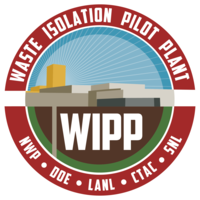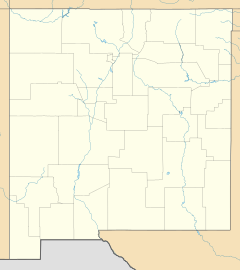
Back محطة عزل النفايات التجريبية Arabic Waste Isolation Pilot Plant German Planta Piloto para el Aislamiento de Residuos Spanish تأسیسات آزمایشی مجزاسازی ضایعات FA Waste Isolation Pilot Plant French Waste Isolation Pilot Plant Italian 核廃棄物隔離試験施設 Japanese Waste Isolation Pilot Plant Dutch Waste Isolation Pilot Plant Polish Waste Isolation Pilot Plant Russian
| Waste Isolation Pilot Plant | |
|---|---|
 Seal of the Waste Isolation Pilot Plant | |
 WIPP, a geological repository for radioactive waste | |
| General information | |
| Type | WIPP |
| Location | 26 mi (42 km) east of Pecos River |
| Country | United States |
| Coordinates | 32°22′18″N 103°47′37″W / 32.37167°N 103.79361°W |
| Opened | March 26, 1999 |
| Website | |
| DOE: Waste Isolation Pilot Plant | |
The Waste Isolation Pilot Plant, or WIPP, in New Mexico, US, is the world's third deep geological repository (after Germany's Repository for radioactive waste Morsleben and the Schacht Asse II salt mine) licensed to store transuranic radioactive waste for 10,000 years. The storage rooms at the WIPP are 2,150 feet (660 m) underground in a salt formation of the Delaware Basin. The waste is from the research and production of United States nuclear weapons only.[1][2] The plant started operation in 1999, and the project is estimated to cost $19 billion in total.[3]
It is located approximately 26 miles (42 km) east of Carlsbad, in eastern Eddy County, in an area known as the southeastern New Mexico nuclear corridor, which also includes the National Enrichment Facility near Eunice, New Mexico, the Waste Control Specialists low-level waste disposal facility just over the state line near Andrews, Texas, and the International Isotopes, Incorporated facility to be built near Eunice, New Mexico.[4]
Various mishaps at the plant in 2014 brought focus to the problem of what to do with the growing backlog of waste and whether or not WIPP would be a safe repository.[5] The 2014 incidents involved a waste explosion and airborne release of radiological material that exposed 21 plant workers to small doses of radiation that were within safety limits.[6]
- ^ "U.S. Department of Energy's Waste Isolation Pilot Plant – WIPP Site". wipp.energy.gov. Retrieved November 8, 2022.
In 1979, Congress authorized WIPP, and the facility was constructed during the 1980s. Congress limited WIPP to the disposal of defense-generated TRU wastes in the 1992 Land Withdrawal Act. In 1998, the U.S. Environmental Protection Agency certified WIPP for safe, long-term disposal of TRU wastes.
- ^ Rubin, Gabriel (May 14, 2021). "Escape From Yucca Mountain: Biden Administration Promises Progress on Nuclear Waste". Wall Street Journal.
The only federally designated long-term disposal site for waste from the nuclear power industry is at Yucca Mountain in Nevada (there is also a site near Carlsbad, N.M., for waste generated by the government's nuclear weapons program).
- ^ Cite error: The named reference
Federwas invoked but never defined (see the help page). - ^ International Isotopes Incorporated, Project Overview, Archived August 22, 2014, at the Wayback Machine. Intisoid.com
- ^ Tollefson, Jeff (March 4, 2014). "US seeks waste-research revival: Radioactive leak brings nuclear repositories into the spotlight". Nature.
- ^ Vartabedian, Ralph. "2014 accident at WIPP ranks among costliest in U.S. history". Albuquerque Journal. Los Angeles Times. Retrieved January 20, 2017.
Twenty-one workers on the surface received low doses of radiation that federal officials said were well within safety limits. No workers were in the mine when the drum blew.

